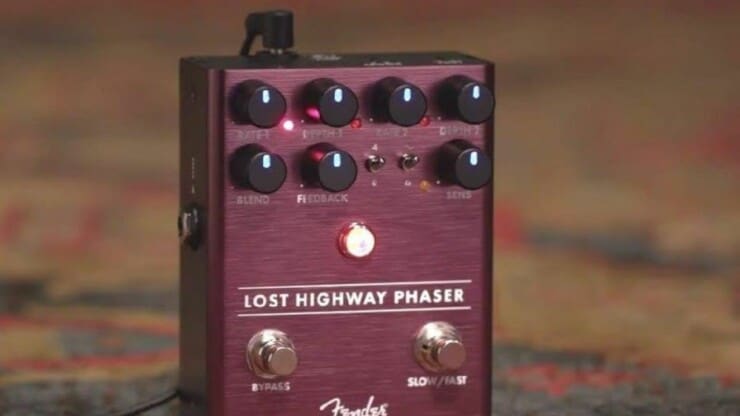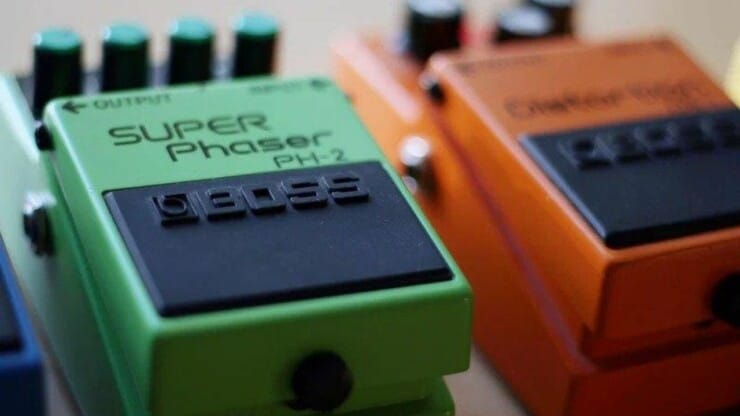Are you a learning guitarist who has been hearing words like phasers and phaser pedals but don’t know what it does? Don’t worry, in this article, you’ll get to know all about it.
A phaser pedal is an exciting pedal that gives the cool, sweeping, filtering, trippy effect. This versatile pedal can be used on the guitar, bass, or any other musical instrument.
In this article, you’ll get to know all about the phaser effect, what is a phaser pedal, how does a phaser pedal work, what does a phaser pedal do, the controls of phaser pedals, and more. Continue reading to get all the answers you’re looking for!
What is the phaser effect?
The phaser effect is the uber-cool sweeping, filtering, modulated, trippy effect that sounds exceptional on a guitar, bass, and other instruments. It can be quite difficult to explain it as a sonic effect and as an electronic processor.
The effect can be achieved by a phaser and is the sweeping modulation of a series of peak filters in a signal’s frequency response. Phasers will produce a series of peaks and troughs within a signal’s EQ. Moreover, they sweep the filters up and down in the audible frequency spectrum. The number of peaks and valleys in a phaser circuit will depend on the circuit. Some phasers will allow you to adjust the number via stages control. The width and rate of the sweeping effect will be adjustable.
Adjusting the parameters will, of course, alter the sound of the phaser, which makes it a versatile effect. With that said, the effect, when noticeable, will be identifiable as being the phaser sound. Stereo phasers can take things one step further and have filtering motion in the left and right channels. One channel’s modulation will be a bit behind the other. Here is where things will get a bit interesting. Is a phaser also a stereo equalizer? Well, no it isn’t. This is the case because it is a modulator, it can be based on a short phase-shifting delay circuit. For producing this effect, phasers will actually utilize a series of all-pass filters.
What does a phaser pedal do?
Now comes the all-important question, what does a phaser pedal do? A phaser pedal will create cuts in the high-end of the signal, with the placement of the cuts being modulated up and down to different positions on the audio spectrum. This will behave like an automatically moving tone control but on a small bunch of frequencies.
Phaser pedals work by creating different notch filters and modulating the center frequency of those filters. A notch filter is a kind of circuit that attenuates a narrow band of frequencies. It can be plotted on a frequency domain range, and it’ll look like a deep slightly curved V. This graph will have the center frequency as the deepest point.
The static notch filters are very interesting, as the narrow band of operation sometimes makes it tough to identify different sounds when running the audio, especially with the guitar. However, as you modulate the center frequency, the effect will be more pronounced and noticeable. It’ll start sounding a bit like turning the tone knob on the guitar automatically but without losing the top end. It will also sound slightly similar to a wah pedal but without the heavy, vocal nature inherent in the effect.
The filtering will be accomplished by creating a phase difference at specific frequencies and mixing the signals with dry signals. This will end up causing frequent-dependent phase cancelation. The way in which this is achieved will vary by design. While each design might operate in a different manner, all of them utilize a circuit that causes phase cancelation at certain frequencies.
How does a phaser work?
A phase is essentially a position on the frequency spectrum when you see a waveform. You’ll be seeing numerous phases starting and ending as they hit the zero-degree axis. The phase-shift sound will be achieved by mixing two identical signals and merging them. The first signal will be a dry input signal, while the other will have multiple peaks and troughs in the frequency spectrum. This is essentially called an all-pass filter, which means any frequency could be cut or boosted. The position of this filter can be moved around using an LFO and the altered signal will be then combined with the original signal.

Due to the movement caused by the LFO, the guitar will go in and out of phase. The frequency spectrums of the signals will then match, then unmatch, then match again. This will create a swirling phaser effect. Phasers make use of all-pass filters in a chain, which is why phasers come with multiple stages and create more complex overtones. In some situations, the output will be feedback partially into the input. This generates feedback that adds another dimension to the sound.
Speed controls of a phaser pedal
Many phaser pedals only come with one control. This is generally labeled as “speed” or “rate”. This control will affect how quickly the modulation is happening or how often the center frequency of the notch filters is shifting up and down.
A slow setting on the phaser pedal can take a long time to cycle. Sometimes, it’ll take so long that it barely sounds like it’s engaged until a note or chord is held. Slow settings can be useful when you don’t want the phaser effect to be noticed. However, you also don’t want the guitar sound to sound static. At higher settings, phasers will start sounding alien and watery. It can be helpful when it comes to increasing intensity, emulating a Leslie on the tremolo setting, or experimenting.
Different phases of a phase shift
Phase pedals will typically come with a setting or specifications related to the number of phase shift stages in the circuit. There are certain phaser pedals in the market that’ll allow you to switch between 2, 4, 6, 8, or more stages or steps. For every 2 stages, another notch in the spectrum will be added. Therefore, an 8-stage phaser may feel more obvious and heavily affected than say, a 2-stage phaser. While certain designs allow for switching, most phasers will come with a fixed number of stages.
For instance, the MXR Phase 45 is a 2-stage phaser and will only create one notch filter. Meanwhile, the small stone will come fixed as a 4-stage phaser, whereas the Mu-Tron Bi-Phase consists of two 6-stage phasers. It can be cascaded into another stage for 12-stages of phase shift.
Depth, mix, and amount
Certain phase shifters come with a depth, mix, or amount of control for affecting how deep the notch filters are cutting. Under the hood, it’ll be done by mixing more of the phase-shifted signals with the dry signal. It can also be done by making the LFO’s control signal comparatively larger. Increasing the depth of the phaser can sometimes lead to darker sounds with intense sensations of pushing and pulling.
Feedback, resonance, and color
A color switch can be found on the Small Stone for introducing feedback into your circuit. As commonly seen on envelope filters or wah filters with increased resonance, this will create a more vocal phase shifting with a more obvious effect overall.
A common mod with the MXR Phase 90 involves either clipping or removing the feedback resistor. This eliminates the feedback in the circuit and makes it sound less distorted and more mellow. This mod has become commonplace when creating a block logo Phase, as it operates similarly to a script logo Phase 90.
The Transmoriphaser comes with a Feedback control for adjusting how much feedback is existing in the circuit. As feedback is dependent on how intense the phase cancelation is, the feedback and depth control will interact with each other significantly.
How will the phaser differ from the flanger and chorus effects?
The phaser, flanger, and chorus are all modulation effects and are related to each other in some way. All three of them rely on a similar sequence of events for producing their distinctive sounds. The three effects will split an audio signal into two separate pathways, a wet signal, and a dry signal. All of them will depend on an LFO for modulating the wet signal, and they’ll affect the interference pattern of the audio signals in some way.
The main difference between phaser, flanger, and chorus effects is that the phase shifter effect will not use a delay for altering the interference pattern of the two signals. Instead, the phaser effect will rely on the LFO’s modulation of the all-pass filters for producing constructive/destructive interference between the two audio signals. Contrast the process with the chorus effect, which makes use of an LFO for modulating the pitch of the wet signal. Meanwhile, the flanger effect uses an LFO for modulating the delay time of the wet signals.
Phaser, flanger, and chorus effects are different in one more significant way. In the latter two, the LFO’s modulation of the wet signal will apply to all the frequencies present in the signal. This will produce a uniform phase shift across the audio signal. However, due to the LFO’s sweep through a sequence of all-pass filters, the phaser effect will offer a degree of unpredictability with the interference pattern. The phase differences in the output signal depend on the input signal frequency, for instance, the phase of the low frequency may be shifted by a quarter of a wavelength. Meanwhile, a higher frequency could be phase-shifted by an entirely different amount.
The differences in these processes are what characterize the Doppler-like whooshing sound in the phase shifter effect compared to the watery and wobbly sounds of the flanger and chorus.
Do phasers sound like Leslie Rotary Speakers?
Phasers sound very similar to the rotating Leslie Rotary Speakers used with organs. A rotary speaker makes use of a rotating horn being fed by a speaker. At low speed, it creates an interesting swirling effect with the sound wave moving. The waves will bounce off different surfaces of the room and give that effect. At high speeds, it’ll create a watery Doppler effect. At low and high speeds, there will be a constant shift in the timbre or tonal character of the sound.
The Leslie Speakers have been historically used with organs for adding life and movement to instruments that feel static when they’re played through traditional, non-moving speakers. Moreover, this effect has later been sued on synthesizers, guitars, and vocals on some recordings. Although phasers aren’t exactly Leslie simulators, they do have similar effects. The idea behind the modulation effects is to create a tonal motion. While the chorus creates a doubled/detuned sound and flangers crate a tubular swooshing sound, phasers will have a subtle, warm texture about them.
Flangers and chorus pedals utilize delay circuits, which will create more notch filters in the spectrum compared to phaser pedals. This is commonly known as comb filtering. Due to this intensified effect, they’ll have a slightly harsh or metallic sound. Phasers tend to be much more mellow and less overbeating.
The history of phaser pedals
The Shin-ei Company’s iconic “UniVibe” became the first successful phase-shifting stompbox pedal. It featured only two controls – an intensity knob and a volume knob. These knobs could be controlled using a connected expression pedal. Psychedelic tones emanated from a sequence of four all-pass filters, and the phaser effect took hold on guitarists like Jimi Hendrix and David Gilmour. This helped give the phaser effect the initial hype and boost it needed for gaining popularity.
In 1971, Eventide came out with the first rackmount phaser effect – the Instant Phaser model PS 101. This model employed a series of 8 FET-based, carefully tuned analog all-pass filters. These filers delivered lush phasing while also preserving the original tone.
By comparing the four all-pass filters of the Shin-ei Company’s UniVibe to the eight all-pass filers of the Phaser model PS 101, it is evident how quickly things progressed with the increasing advancements in technology. However, having more complex effects isn’t always the superior option. In 1974, the MXR brand came out with its first product, the historic Phase 90. Many versions of Phase 90 are still being produced today. It still remains among the most popular and significant phaser pedals in history. Phase 90’s biggest strength lies in its simplicity. Phase 90 came with a single knob to control the speed of the phaser’s sweeping effect.
1974 also saw the highly anticipated debut of the primary rival of Phase 90 – the Electro-Harmonix Small Stone. Very similar to Phase 90, the EHX Small Stone was also a four-stage phase shifter that come with a control knob for rate and a switch that was labeled “color”. Both Phase 90 and the EHX Small Stone have passed through several phases in their production. They still remain two of the most significant and popular phaser effect pedals in history.

Music is often all about the relationship between different moments, whether you’re changing chords, rhythms, melody, or timbre. Phasers will be a great way of introducing a timbral change without actually throwing off the entire personality of the tone. They’ll be less aggressive than say flangers or wah pedals, while being more flexible than tremolos or pitch shifting.
A phaser might not be perfect for every situation. However, they are far more useful than people think. If you’ve not tried your hand at a phaser pedal, there are many exciting options to choose from. You can always go for the Transmogriphaser pedal, which is a fun pedal to use. Then, there are also the Electro-Harmonix Small Stone and MXR Phase 90 pedals, as they’re excellent options to begin your explorations. Whether you’re into rock, funk, electronic music, or avant-garde experimentation, you will always find a phaser pedal useful.
Conclusion
Thank you for reading. Hopefully, now you know a lot more about the phaser effect, what is a phaser pedal, how does a phaser pedal work, what does a phaser pedal do, the controls of phaser pedals, the history of phaser pedals, and more. A phaser pedal is a handy little effect pedal that’ll give you the sweeping, filtering, trippy, modulation effect to your music. This pedal works by creating different notch filters and then modulating the center frequency of the filters to give a cool sound. This extremely versatile effect pedal will work great for guitar, bass, or just about any musical instrument.
Image Credit:
Images: Sustain Punch, Guitar Space



